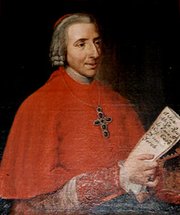Henry Benedict Stuart
|
|
Henry Benedict Maria Clement Thomas Francis Xavier Stuart (March 11, 1725 – July 13, 1807), born in Rome, Italy, was a Prince of England and of Scotland, Duke of York, and Cardinal of the Roman Catholic Church. Known by Jacobites as Henry IX and I, King of England, Scotland, France, and Ireland (January 31, 1788 – July 13, 1807). He was the second son of James Francis Edward Stuart, known as The Old Pretender. His mother was Maria Clementina Sobieski, granddaughter of the Polish king John III Sobieski.
He went to France in 1745 to help his brother, Prince Charles Edward Stuart (Bonnie Prince Charlie), preparing the Jacobite campaign of that year. After its defeat, Henry Stuart returned to Italy, and in 1747 the Pope made him a Cardinal and in 1748 ordained him a priest. In 1761 he was also made bishop of Frascati, a town near Rome, where he lived and worked for years.
In 1784, when his brother Charles was dangerously ill, Henry proclaimed that he would continue to use the title Cardinal Duke of York as an incognito should he become king. On the death of his brother, Charles Edward Stuart on January 31, 1788 Henry Stuart considered himself King Henry IX and I; he was the last of the direct male line of James II and VII and the last genuine pretender to publicly claim the thrones of Britain.
At the time of the French Revolution, he lost his French Royal benefices yet sacrificed many other resources to assist the Pope. He was reduced to poverty by the seizure of his Frascati property by the French. He sailed to Padua and then to Venice for the papal conclave of March 1800.
The British Minister in Venice arranged for Henry to receive an annual payment of £4000 from King George III of Great Britain. The Hanoverians represent this as an act of charity, however Jacobites followed Henry's view that it was no more than a first instalment on the money which was legally owed to him. (For many years the British government had promised to return the English dowry of his grandmother, Mary of Modena, but had never actually done so.) He returned to Frascati and in September, 1803, became Bishop of Ostia and Velletri, and Dean of the Sacred College, though he still lived in the episcopal palace at Frascati, where he died, July 13, 1807. Henry was one of the longest serving cardinals in the history of the Roman Catholic Church, serving in that office for over 60 years.
Under his will, which he signed as Henry R, he was succeeded in all his claimed British rights by his nearest blood relative, Charles Emmanuel IV of Savoy. Like Henry Stuart, Charles Emmanuel IV was a Catholic.
Contrary to popular belief, he did not leave the crown jewels to the Prince of Wales, afterwards George IV of the United Kingdom. All his property was entrusted to Monsignor Angelo Cesarini for distribution. Cesarini sent the Prince Regent several jewels from Henry's private collection. These included a "Lesser George" (thought to have been worn by King Charles I at his execution, and now at Windsor Castle) and a St Andrew's Cross (now at Holyrood Palace in Edinburgh), which are insignia of the orders of the Garter and the Thistle, and also a ruby ring.
Henry, his brother and father are buried in the crypt of St. Peter's Basilica in the Vatican. There is a monument to the Royal Stuarts designed by Antonio Canova in the basilica to their memory.
A new sarcophagus was needed when the bodies were moved in 1938. It is widely held that the cost of that new sarcophagus was paid by King George VI.
External link
- Henry Benedict Maria Clement Stuart (http://www.newadvent.org/cathen/14316b.htm) Catholic Encyclopedia article
| Preceded by: "Charles III" | Jacobite succession 1788–1807 | Succeeded by: "Charles IV" |

